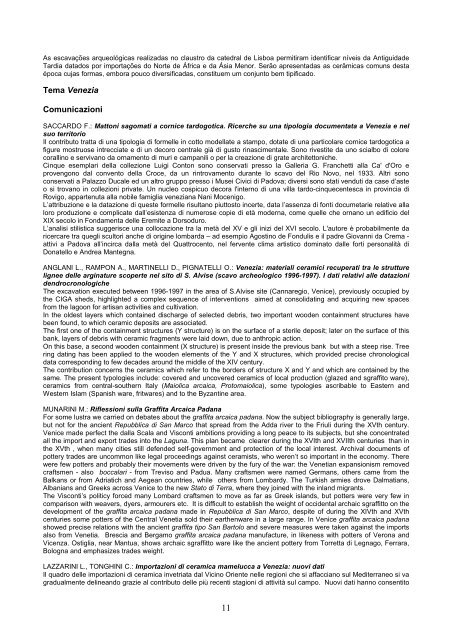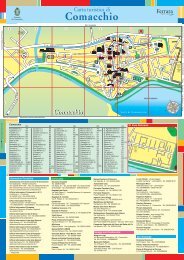Abstracts - Archeologia Medievale Venezia
Abstracts - Archeologia Medievale Venezia
Abstracts - Archeologia Medievale Venezia
Create successful ePaper yourself
Turn your PDF publications into a flip-book with our unique Google optimized e-Paper software.
As escavações arqueológicas realizadas no claustro da catedral de Lisboa permitiram identificar níveis da Antiguidade<br />
Tardia datados por importações do Norte de África e da Ásia Menor. Serão apresentadas as cerâmicas comuns desta<br />
época cujas formas, embora pouco diversificadas, constituem um conjunto bem tipificado.<br />
Tema <strong>Venezia</strong><br />
Comunicazioni<br />
SACCARDO F.: Mattoni sagomati a cornice tardogotica. Ricerche su una tipologia documentata a <strong>Venezia</strong> e nel<br />
suo territorio<br />
Il contributo tratta di una tipologia di formelle in cotto modellate a stampo, dotate di una particolare cornice tardogotica a<br />
figure mostruose intrecciate e di un decoro centrale già di gusto rinascimentale. Sono rivestite da uno scialbo di colore<br />
corallino e servivano da ornamento di muri e campanili o per la creazione di grate architettoniche.<br />
Cinque esemplari della collezione Luigi Conton sono conservati presso la Galleria G. Franchetti alla Ca' d'Oro e<br />
provengono dal convento della Croce, da un rintrovamento durante lo scavo del Rio Novo, nel 1933. Altri sono<br />
conservati a Palazzo Ducale ed un altro gruppo presso i Musei Civici di Padova; diversi sono stati venduti da case d’aste<br />
o si trovano in collezioni private. Un nucleo cospicuo decora l'interno di una villa tardo-cinquecentesca in provincia di<br />
Rovigo, appartenuta alla nobile famiglia veneziana Nani Mocenigo.<br />
L’attribuzione e la datazione di queste formelle risultano piuttosto incerte, data l’assenza di fonti documetarie relative alla<br />
loro produzione e complicate dall’esistenza di numerose copie di età moderna, come quelle che ornano un edificio del<br />
XIX secolo in Fondamenta delle Eremite a Dorsoduro.<br />
L’analisi stilistica suggerisce una collocazione tra la metà del XV e gli inizi del XVI secolo. L'autore è probabilmente da<br />
ricercare tra quegli scultori anche di origine lombarda – ad esempio Agostino de Fondulis e il padre Giovanni da Crema -<br />
attivi a Padova all’incirca dalla metà del Quattrocento, nel fervente clima artistico dominato dalle forti personalità di<br />
Donatello e Andrea Mantegna.<br />
ANGLANI L., RAMPON A., MARTINELLI D., PIGNATELLI O.: <strong>Venezia</strong>: materiali ceramici recuperati tra le strutture<br />
lignee delle arginature scoperte nel sito di S. Alvise (scavo archeologico 1996-1997). I dati relativi alle datazioni<br />
dendrocronologiche<br />
The excavation executed between 1996-1997 in the area of S.Alvise site (Cannaregio, Venice), previously occupied by<br />
the CIGA sheds, highlighted a complex sequence of interventions aimed at consolidating and acquiring new spaces<br />
from the lagoon for artisan activities and cultivation.<br />
In the oldest layers which contained discharge of selected debris, two important wooden containment structures have<br />
been found, to which ceramic deposits are associated.<br />
The first one of the containment structures (Y structure) is on the surface of a sterile deposit; later on the surface of this<br />
bank, layers of debris with ceramic fragments were laid down, due to anthropic action.<br />
On this base, a second wooden containment (X structure) is present inside the previous bank but with a steep rise. Tree<br />
ring dating has been applied to the wooden elements of the Y and X structures, which provided precise chronological<br />
data corresponding to few decades around the middle of the XIV century.<br />
The contribution concerns the ceramics which refer to the borders of structure X and Y and which are contained by the<br />
same. The present typologies include: covered and uncovered ceramics of local production (glazed and sgraffito ware),<br />
ceramics from central-southern Italy (Maiolica arcaica, Protomaiolica), some typologies ascribable to Eastern and<br />
Western Islam (Spanish ware, fritwares) and to the Byzantine area.<br />
MUNARINI M.: Riflessioni sulla Graffita Arcaica Padana<br />
For some lustra we carried on debates about the graffita arcaica padana. Now the subject bibliography is generally large,<br />
but not for the ancient Repubblica di San Marco that spread from the Adda river to the Friuli during the XVth century.<br />
Venice made perfect the dalla Scala and Visconti ambitions providing a long peace to its subjects, but she concentrated<br />
all the import and export trades into the Laguna. This plan became clearer during the XVIth and XVIIth centuries than in<br />
the XVth , when many cities still defended self-government and protection of the local interest. Archival documents of<br />
pottery trades are uncommon like legal proceedings against ceramists, who weren’t so important in the economy. There<br />
were few potters and probably their movements were driven by the fury of the war: the Venetian expansionism removed<br />
craftsmen - also boccalari - from Treviso and Padua. Many craftsmen were named Germans, others came from the<br />
Balkans or from Adriatich and Aegean countries, while others from Lombardy. The Turkish armies drove Dalmatians,<br />
Albanians and Greeks across Venice to the new Stato di Terra, where they joined with the inland migrants.<br />
The Visconti’s politicy forced many Lombard craftsmen to move as far as Greek islands, but potters were very few in<br />
comparison with weavers, dyers, armourers etc. It is difficult to establish the weight of occidental archaic sgraffitto on the<br />
development of the graffita arcaica padana made in Repubblica di San Marco, despite of during the XIVth and XVth<br />
centuries some potters of the Central Venetia sold their earthenware in a large range. In Venice graffita arcaica padana<br />
showed precise relations with the ancient graffita tipo San Bartolo and severe measures were taken against the imports<br />
also from Venetia. Brescia and Bergamo graffita arcaica padana manufacture, in likeness with potters of Verona and<br />
Vicenza. Ostiglia, near Mantua, shows archaic sgraffitto ware like the ancient pottery from Torretta di Legnago, Ferrara,<br />
Bologna and emphasizes trades weight.<br />
LAZZARINI L., TONGHINI C.: Importazioni di ceramica mamelucca a <strong>Venezia</strong>: nuovi dati<br />
Il quadro delle importazioni di ceramica invetriata dal Vicino Oriente nelle regioni che si affacciano sul Mediterraneo si va<br />
gradualmente delineando grazie al contributo delle più recenti stagioni di attività sul campo. Nuovi dati hanno consentito<br />
11





